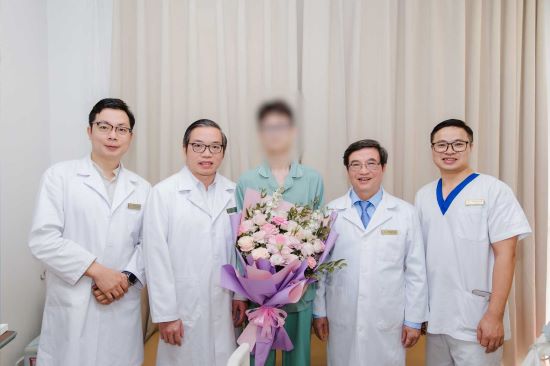
Doctors congratulate patient on discharge
Additive Manufacturing Saved Teenager With Bone Cancer
The successful operation to remove a 2kg cancerous tumour took place in Vinmec International Hospital in Vietnam, lasting 8 hours, presided by a team of 30 medical professionals.
Typically, when cancer tumours are in complicated areas, patients are often at high risk of death during surgery, even in advanced nations. In this case, the large tumour was found to be in the patient’s pelvic floor.
Vietnam encounters only between five and ten similar cases each year — accounting for 5% of bone cancer cases. The patient suffered numbness in the pelvic area, limiting his movement and gait. Several consultations with doctors concluded with prognosis of mild soft tissue injuries incurred from playing sports, despite the huge protrusion.

Image credit – Vinmec International Hospital
Vinmec’s medical experts realised the cancerous tumour is supplied by a large and complex vascular system, resulting in possible loss of up to 10 litres of blood during surgery. On the other hand, the tumour’s compression on vital organs such as the digestive system, urinary system, spine, pelvis, and blood vessels was a challenge to approach.
In a case of hemorrhage, it would lead to an uncontrollable situation without clearly revealing the tumour and related parts. However, without surgery, the patient would face the risk of left leg muscle atrophy, and eventually death.
Additive Manufacturing — Prelude To Procedure
The technology greatly help the medical team plan the procedure by printing the tumour, consequently, providing a visual and accurate assessment of shape, volume, and correlation with vital organs. Based on that, doctors could plan the operative approach and minimise complications.

3D-printed tumor model with a 1:1 ratio to help doctors plan precise surgery
Prior to the surgery, the radiologists embolised large blood vessels of the tumor to minimise blood loss during surgery. The next day, cardiologists, gastroenterologists, and urologists participated in the initial phase of surgery. Cardiologists exposed and controlled the iliac artery, and may perform ligation when bleeding is severe. The urologist then released the bladder and ureters from the tumor, and the gastroenterologist performed a dissection to protect the digestive tract.
Orthopedic experts removed the tumour through two incisions in the abdomen and behind the thigh. During the major surgery, the team of anesthesiologists continuously monitored and adjusted to maintain a stable state and minimise post-operative complications simultaneously. The team that participated in this major procedure comprised over 30 medical professionals. The process took 8 hours.
The patient resumed normal activities after three days and was discharged a week after. However, he was advised to wait for the pathology results is necessary to consider radiotherapy, but it is only an additional method. In this case, successful surgery is the best treatment for cancer.
Currently, there are few centers in the world applying 3D printing technology to disease models for preoperative planning of complex cases. Vinmec is the first and only unit to carry this technology in Vietnam. Presently, 100% of bone, joint, and cancer surgeries at Vinmec are performed in the same process: a virtual surgery (on the software), an experimental surgery (on the model), and then an actual surgery (on the patient).

Prof. Ph.D. Dr. Tran Trung Dung – Director of the Center for Orthopedics and Sports Medicine, Vinmec International Hospital
Prof. Ph.D. Dr. Tran Trung Dung – Director of the Center for Orthopedics and Sports Medicine, Vinmec International Hospital said: “The giant bone tumour in the pelvis (like a pregnant woman) compressed the left sciatic nerve, causing numbness and left leg atrophy. Untimely treatment leads to loss of function in the left leg, and is even life-threatening.
”Due to the increased size of the tumour, it would compress and cause blockage in the digestive or urinary system. Therefore, it is necessary to remove early to help restore limb function and avoid distant complications of the digestive and urinary systems.”
What You Missed:
AI Chatbot Disabled After Writing A Self-Scathing Poem About Company
ALI Technologies’ Flying Bike Fails To Take Off
Metal Prices To Ease With Softening Demand According To World Bank
Hyundai Mobis Unveils MOBION Featuring e-Corner System That Enables Sideway Movement
CES 2024 Showcases Latest Innovations In AI, Sustainability And Mobility
Tesla Dethroned By BYD As World’s Best Selling EV Maker
Quang Ninh Industrial Zones Face Electricity Shortage
Siemens And Intel To Collaborate On Advanced Semiconductor Manufacturing
Universal Robots Launches 30 Kg Cobot
Charlie Munger, The Man Who Saw BYD’s Potential Passes At 99
WANT MORE INSIDER NEWS? SUBSCRIBE TO OUR DIGITAL MAGAZINE NOW!
CONNECT WITH US: LinkedIn, Facebook, Twitter
Letter to the Editor
Do you have an opinion about this story? Do you have some thoughts you’d like to share with our readers? APMEN News would love to hear from you!
Email your letter to the Editorial Team at [email protected]
